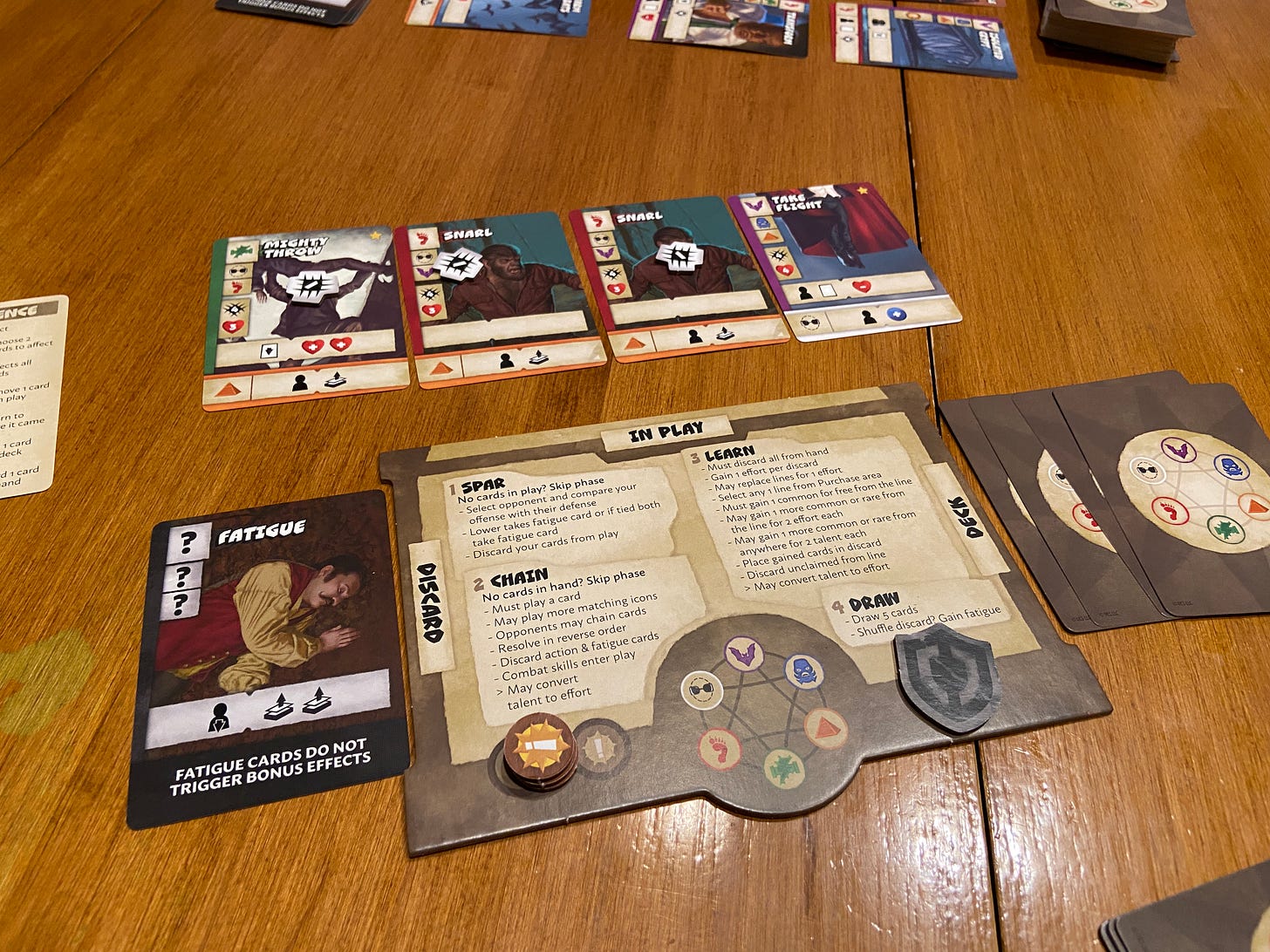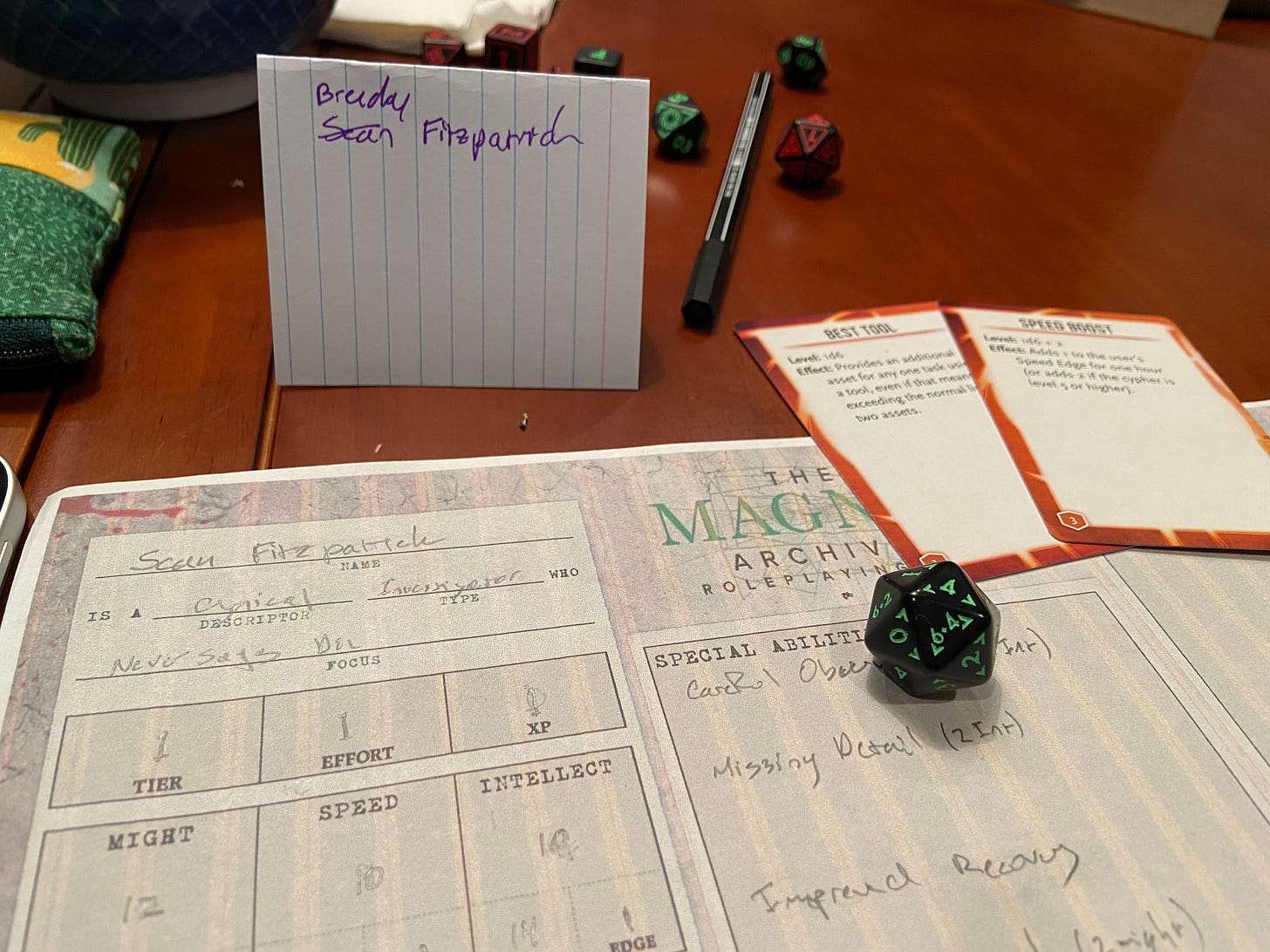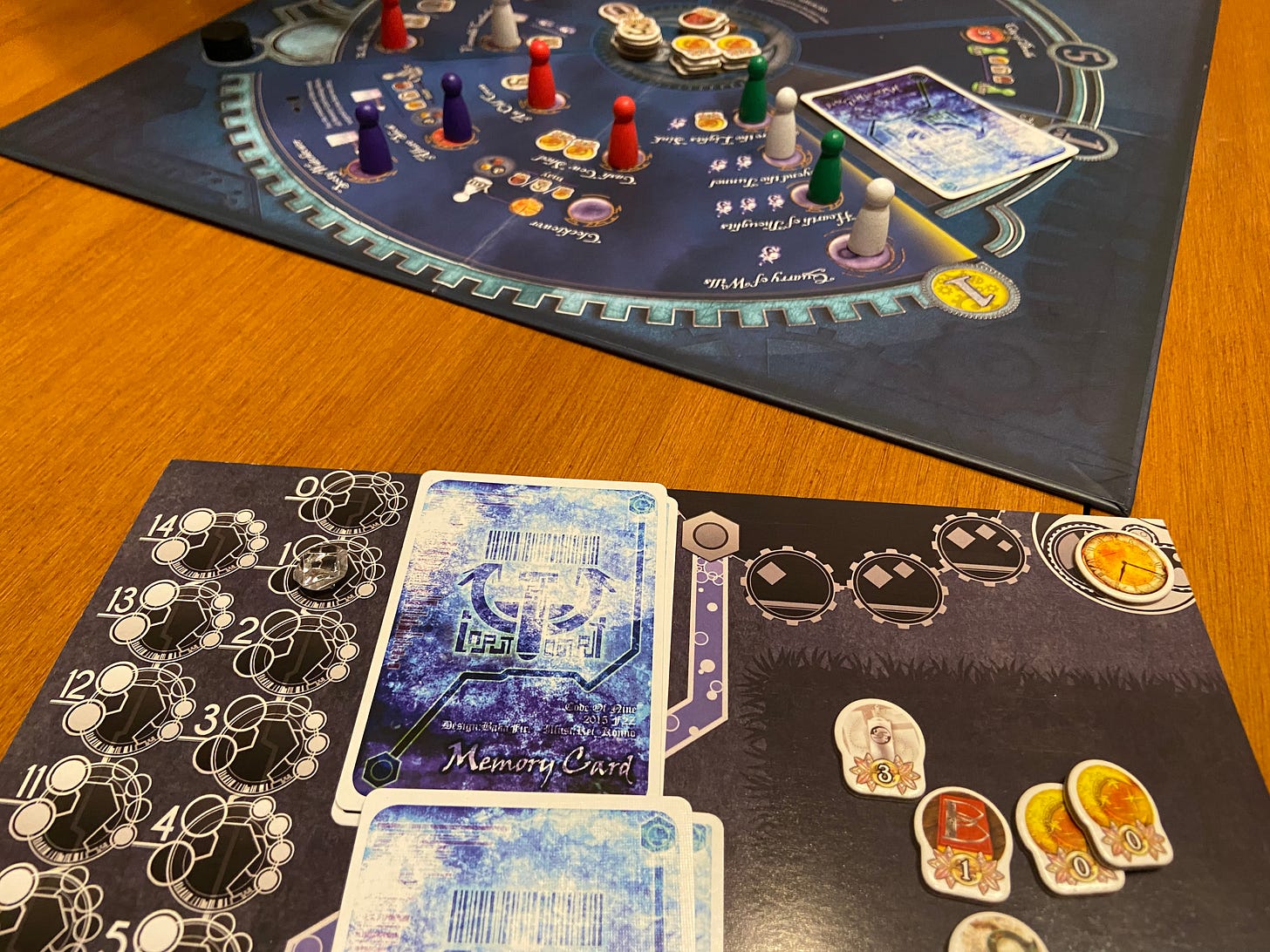Unchained is last year’s remake of AEG’s 2010s deckbuilder Nightfall. I’m not clear how much of an audience the earlier game ever found, it was definitely a very unusual game, but it did go on to have 6 expansions and an iOS app before disappearing after a run of just a couple years. I always found it entertaining, perhaps because it was such an oddball game and nicely thematic, but I never got to play it as much as I would I have liked — most of my plays were on the now-long-defunct app. Anyway, when I saw it had come back with a new smaller-box format, a Universal Monsters retheme, and with apparently streamlined gameplay, nostalgia kicked in and I tracked it down.
Unchained is a euro-adjacent deckbuilder but unusual in that it involves directly attacking your fellow-players, with the player who ends up taking the least damage winning. The core mechanic is a kind of crazy card play “chain”. The current player has to start off the chain by playing a card from their hand. Each card has a suit, and two different suits that can follow it. You can keep playing as long as you can keep chaining, and then the opportunity to play passes to the next player who can continue playing off the last card played. This continues until everyone has had a chance to add to the chain. Then — and this can be the head-explode-y bit for some folks — the chain is resolved one card at a time, from last to first. The cards are either combat cards or actions. Combat cards have an attack and defense value and go into play in front of you, while action cards have an instantaneous effect. The thing you have to remember is that cards that were played earlier in the chain have not been resolved yet and so are not legitimate targets.
Your turn consists of first attacking one other player of your choice, possibly inflicting a fatigue; then discarding all your attacks in play and start a new chain; then acquiring new card(s) for your deck; then discarding any cards you have left and drawing up to 5.
The way that everyone plays onto the chain on everyone else’s turn, and has to constantly play off other players’ cards, gives Unchained a level of speed and interactivity that is crazy compared to most other more straightforward deckbuilders. It really does have the feel of a wild melee. It can feel quite chaotic, and it is, but it also gives you lots of little ways to seek advantage. You need to be able to chain off your right-hand neighbor’s cards, but you also want to be able to develop sequences yourself. You have a hand of 5 cards which has to last you around the table, so there is more pressure on card efficiency than in most deckbuilders. Interestingly though, each time you cycle your deck you take a fatigue. This drives forward momentum because while bloating your deck with unplayable junk still isn’t helpful, adding even just ok cards gives you staying power.
A lot of the tactics are, as you might imagine, just in timing. Attack cards you put into play on your turn will defend right away, but won’t attack until your next turn. But remember you’re playing on everyone’s turns, so if you can time it you can dump just enough attacks into play on the turn of the player to your right. You don’t want to over-commit to either attack or defense because attack cards on the table are vulnerable to effects, so ideally you get down enough new defense every player turn to manage the next player. But of course the cardplay opportunities offered by chaining can be really unpredictable, so there is a strong risk management component.
Having just written the last few paragraphs I’m thinking to myself that all sounds awesome, so why isn’t this in my pantheon of great games? It’s probably pretty obvious: the chaining mechanic is very unintuitive for most people. All these fun timing details emerge from a system that is really hard to visualize or predict until you get the hang of it, and that can take some time. How to think about expanding your deck in this highly fluid situation with a lot of oblique effects is not clear. You’re building your deck from an Ascension-like grid of available cards, and how to somehow manipulate that selection of cards into a deck that works in this highly opportunistic system takes time to figure out. If you’re like me, there is a certain amount that can be derived from first principles but a lot of it is just going to be experimentation, buying cards based on a theory of what works and seeing how it plays out. It’s true that in general complex and opaque game systems don’t work for me, and Unchained is opaque. Still I think it charms me because as you get the hang of it, it’s possible to come to grips with a couple of important levers (timing, attack balance, card flow, color balance) and work them — and you get feedback pretty quickly. The underlying system actually is not very complicated. It just takes some effort to get at.
Two last things that bear mentioning. First, all the effects in the game are described with a scheme of icons. One of these icons (“return to where it came from”) is confusing to say the least, and the icon that denotes the discard pile is never explained as far as I can tell. The icons are almost good, and you get the hang of it when combined with the rulebook that contains text explanations of all the powers, but it’s a clear obstacle to understanding the game and the game does not need extra obstacles. Secondly, the game is rated at 60 minutes. That would be great, and I think it might even be accurate for players who know how to work the game, but people new to the system are unlikely to be able to manage anything close to that. Our game closed in on two hours (we definitely struggled with the implications of chaining), and the crowd was getting antsy. I do think most people will be able to play it faster than we did, but the length is a potential problem.
As you can tell, I like the game, but I do think it appeals to my idiosyncratic sensibilities more than most. I’m not usually attracted to mechanics-first games but this one is just so unique, and it generates an environment that is simultaneously crazy, fluid, and tractable. Clearly that’s a sweet spot for me, given my affection for Up Front, Burning Banners, Dice Realms, Ra, and others. If you enjoy just seeing what designers are trying out with the game form, it’s worth checking out. Likewise, if you enjoyed old-school free-for-alls like Guerrilla, Atlantic Storm, and Modern Naval Battles, but want something with more modern euro sensibilities and that is more sophisticated than King of Tokyo but retains the charms of that form, it’s definitely an interesting game.
I played my first TTRPG since our Invisible Sun game concluded early in the summer: The Magnus Archives, from Monte Cook Games. This is based on a horror podcast of the same name, which I can highly recommend. I’ve wearied of the whole Cthulhu mythos thing, which I feel has become more meme than anything else and which suffers from some issues with the source material. The Magnus Archives has a strong “modern non-problematic Lovecraft” vibe of psychologically taut horror, but it has the advantage of an extra century of evolution of the form: consistent style, tighter narrative, focused world-building, and appropriately epic for a full 5-season arc. Plus of course, more relatable for the modern audience. Which is definitely helpful.
The Magnus Archives RPG uses MCG’s Cypher System, which I like quite a lot even though I don’t get to play it often. It’s a clean, tight, modern system. You can see its origins in old school D20 RPGs (Monte Cook was one of the designers of D&D3) and it works extremely well in the classic fantasy Numenera setting, for which it was originally designed. The Magnus Archives highlights how the system has evolved over the past decade-plus, as it’s expanded to encompass more genres and settings as well as gotten feedback from the player community. It was always player-centric, but it’s now embraced the more explicit player narrative control of systems like Gumshoe (my other favorite system). It’s also now got an improved damage system and a nice structure for character narrative arcs. It’s still lightweight and highly playable, while retaining some of the crunch that players like (in a similar way to the Powered but the Apocalypse system I feel like, although I’m not a PBTA fan).
The Cypher System was born out of a desire to have a system that centered exploration and discovery, and The Magnus Archives is a great fit for that. The core activity of the game is investigating the paranormal. Although somewhat structurally similar to the X-Files, there is no tension between skeptics and believers here — in each episode there is a paranormal threat which the players have to try to understand and decide what to do about.
As someone who isn’t super-into classic horror but is a big fan of The X-Files and enjoys investigative RPGs like Trail of Cthulhu and Night’s Black Agents, but also enjoys the slightly more sophisticated and optimistic fantasy that is the heart of MCG’s brand (Numenera, Arcana Unearthed, and Arcana Evolved), The Magnus Archive was always going to be a game that appealed to me. It was nice to be reminded that Monte Cook is still the best, and he is still learning how to do this stuff better. The Cypher System isn’t a panacea, like everything else it still needs to be used skillfully, but when done right it really does get out of the way and let you focus on the story. Which is all I ask.
I’ve been trying to get Code of Nine to the table again for a little while. This is a Bakafire (Tragedy Looper, Sakura Arms) game from 2012. I love his games and playing this again helped me clarify what it is about his style that appeals to me. They’re mechanically clean and focused — extremely euro-y in that way — but also very thematically and narratively satisfying. In Code of Nine we play guardians trying to fulfill the wishes of a mysterious, long-dead society. In the game that means that each player has two secret cards with endgame scoring rules. There are 5 turns of a worker placement game of acquiring resources and jockeying for position, and at the end we reveal all the cards and see who best fulfilled the desires of the ancients.
On the one hand, the game is fundamentally a very simple one of watching what the other players do and trying to deduce the victory conditions. It has a little bit of Argent: The Consortium in it in that way. The game is so short that there isn’t a lot of time for bluffing, so there should be plenty of signal to read. On the other hand, there are enough tactical details and little bits of thematic filagree — attack/defense actions, peeking at other players scoring cards, items called legacies that can be retrieved and cooperatively released, and so on — to give it some narrative and emotional depth.
I like Code of Nine a lot. It’s simple, it’s short (45 minutes), it’s got thematic and narrative momentum, and it’s also an interesting game. Doing this kind of guessing game of figuring out what other players’ objectives are is incredibly difficult. Games usually either don’t give you enough information (making it too hard) or give you too much (making it too easy). Code of Nine manages to maintain ambiguity most of the game and therefore forces you to watch and guess, but it gives you enough information to feel like you’re doing it in a grounded, rational way and can make with each move. It’s very rare for a game to be able to deliver on that.
Coda
You really haven’t heard Bach’s Cello Suites until you’ve heard the original version for bass clarinet.
That’s it! Thanks for reading, and see you next week!





Man, I love Nightfall. Still looking for a couple of those rare expansions...
The chaining mechanic and combat were no big deal to anyone who had played MtG. But the (awesome, actually) post-apoc monsters theme turned some people off for sure.
My only gripe was the thematic clash between multiple players playing multiple copies of a card that was purporting to represent a particular monster. Sounds like Unchained has fixed that somewhat by making the cards all actions or abilities.
I've got enough Nightfall cards... I wonder if it would be possible to build an "Epic" variant that weeded out the multiples?
Code of Nine looks like something one of my regular gaming buddies would dig! Good shout.